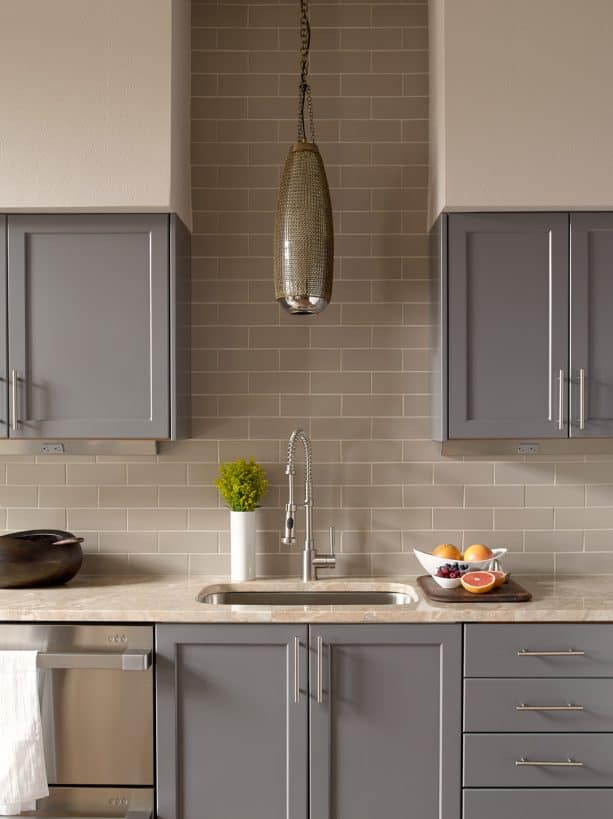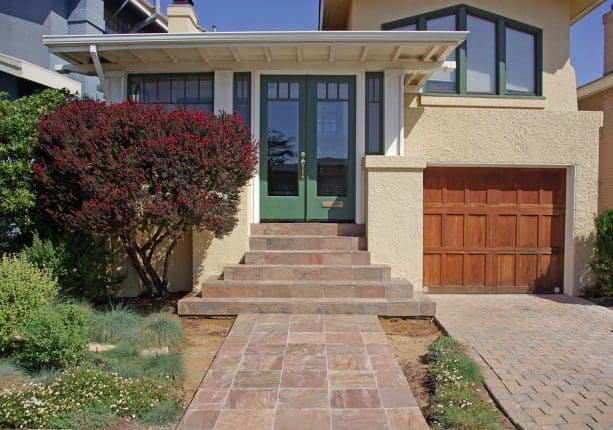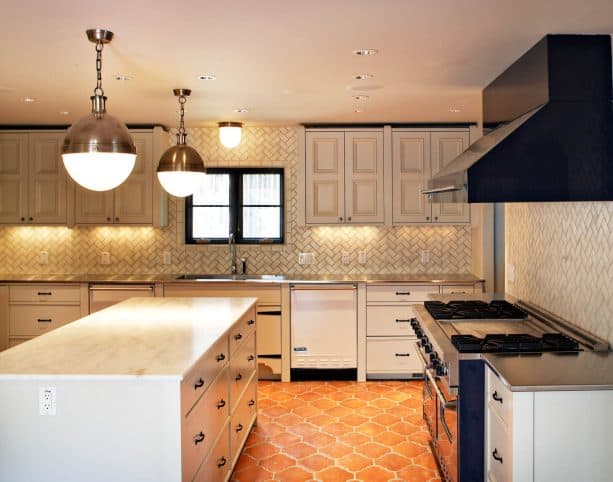Beige is the kind of color that can be a great alternative to white. That’s why beige tile is quite popular these days.
It can also create a luxurious yet minimalist look in a room if you know how to pair it.
When it comes to tiling, what color grout to use with beige tile may be the last question on your mind.
However, finding the best color for your grout can be as exciting as choosing the one for the tile itself.
You may have known that tiling is actually a big investment in the home, so make sure you’ve got all the elements right, including the grout.
Whether you match the color to the tiles to create a low-key appearance or you want to make a statement with a contrasting color, the decision can totally bring your finished tiles to life.
Here are some best grout colors that can perfectly accentuate your beige tiles:
1. White

This master bathroom features a beige mosaic ceramic tile, creating a spa-like ambiance.
It seems that the designer wanted to keep a minimalist style. The color combo is calm and simple but at the same time luxurious and elegant too. That’s what you get if you stick to neutral colors.
The main color used here is brown, but the designer managed to combine a few different shades.
The floor tile has a combination of brown shades, similar to the wall tile in the shower. The wall is also finished in beige, which is a combination of brown and white, and it seems that the beige color is the dominant color. It’s supposed to be a canvas for the accent color added.
One of the accent colors is white, which you can see on the grout. A combination of white grout and beige tile is popular because they complement each other.
If you want to create a subtle contrast, always rely on white grout for the beige tiles. White will make the beige look softer and calmer but at the same time creates a contrast too.
2. Off-white

The color combination and the various shapes of the elements used in this bathroom create a harmonious look.
They create something beautiful, comfortable, calming, lovable, new, and eclectic, even though basically this is a traditional bathroom.
Despite the harmony, everything used in this bathroom reflects the vintage style but with an addition of fun, whimsical, and oddity.
The tiles look different, even though basically the designer stated that they used granite tiles and all of them were cut from the same slab. They also share the same color, except for the dark brown edging around the tub, which is beige.
All of the beige tiles are completed with a grout color that was a bit away and off from the tile. It’s obviously meant to create a subtle contrast but not blend with the tiles.
It looks like an Antique White or Laticrete grout color. The off-white grout is meant to complement all the color combo.
Off-white can deliver a complementing look to the beige tiles and a contrasting look to the dark brown tile on the perimeter.
In a beige tile next to the dark blue wall, off-white grout can also make the beige tile look more prominent.
3. Light Tan

If you think white grout against beige tiles is overrated, you might want to consider choosing another neutral tone that can serve as a perfect backdrop for your tiles.
Light tan is an excellent alternative for white or off-white.
According to the designer, the grout used in this beige subway tile backsplash is #172 Urban Putty from Custom Building Products, which is actually a light tan shade.
Tan and beige both have a touch of brown. And in light tan and beige, the brown color in them is soft and muted.
From this angle, the light tan grout looks almost white, but if you take a look at it closer, you’ll see that it’s darker than white but lighter than brown.
A combination of light tan and beige can be used as a backdrop for other neutral colors in a darker tone.
For instance, in this kitchen, the beige/light tan subway tile backsplash delivers an excellent look to the dark gray cabinets. They make the dark gray look pop. But the countertop and the walls are meant to complement them.
This is a great look to copy if you want to create a similarly soft color scheme.
4. Gray

Compared to the previous pictures, the beige shade in this stone-tiled walkway and stairs is a bit darker.
However, like other stone materials, this tile comes in multicolor, so the beige shade is not uniform.
For an outdoor look, it’s better than using a solid-colored beige tile, because tile in the shade like this is more attractive and able to enhance your curb’s appeal.
Due to the darker shade of beige, the landscaper thought it would be better to pair it with gray grout.
A combination of gray and beige tile is not that uncommon, but gray is not the first color that comes to your mind if you have to choose a grout for your beige tile, especially dark gray.
However, the landscaper proves that gray grout can complement a darker shade of beige, especially if it is a stone slate tile in different shades of beige.
Some of the beige shades have a tint of gray color, too, because, after all, slate is naturally gray. The gray grout will accentuate the entire look of the beige tile.
Some of the tiles look contrasted by the gray, while some others look complemented. The inconsistency throughout the walkway delivers a whimsical look that’s perfect for a transitional style.
5. Brown

In a spacious master bathroom, it would be great if you incorporated a light neutral color palette.
Light tone can make the room feel bigger and, at the same time, deliver a warm ambiance.
In this case, beige is better than white because sometimes white can look too start and intimidating, while beige, with a touch of brown color, is more calming and refreshing.
This bathroom has a combination of brown shades, from dark, taupe, and beige. The floor has multicolor with a mixture of dark and light tones, while the wall is fully beige, with the exception of a shower wall, which is taupe colored.
The floor tile is Solistone Anatolia Rumi Pebble mosaic tile, while the recessed center wall shower is Monique Taupe,
It seems that all of the tiles are completed with brown grout. It’s Custom Light Smoke #145, which is actually a brown color.
Using a brown color for beige tile and other shades of brown will create a blend-in look. You should choose this grout color if you want a natural finish, and the grout is barely noticeable.
Why just settle for beige if you can go full brown?
6. Black

If you want to create a luxurious look, never forget to incorporate black color, no matter how little it is.
Black is usually associated with sophistication and luxury. If you can pair it well, you’ll create a modern and stylish room that no one can resist.
Black and beige are both neutral colors, even though they have a different tones. They will create contrast as classic as the black and white combo, but with a better visual.
See how the beige tiles in this bathroom are completed with black grout. The floor tile and the wall in the shower tile are nearly the same with beige color. They deliver a wood-looking appearance, an excellent alternative for real wood.
All the tiles here are from Atlas Concorde, Etic Collection in Ulivo color. The wall tile in the shower is “Re-Use Concrete” in Fango Sand Lappato” color and smooth finish.
The grout looks prominent even from this angle because, basically, beige and black contrast each other. Even though the shade of beige in this bathroom looks a bit dark, it still looks odd against the black grout.
This is an excellent way to go if you want to make a popped up look in your tiling. Plus, black grout pulls off a modern vibe too.
7. Gold

The herringbone-patterned tile in this backsplash looks almost white, but it’s actually beige. It appears white because it’s paired with gold metallic grout, which can tone down the beige’s dark tone and make it paler than it actually is.
Using metallic backsplash will never fail to enhance the visual in your room.
Similar to black, gold can also make the room look luxurious and elegant. There’s nothing more royal than gold. Its rich tone makes it a perfect element to draw much attention.
See how the gold grout in this beige backsplash look stands out. Even the beige backsplash in the herringbone pattern that’s supposed to be the main point looks pale and a bit dull against this striking metallic shade.
Moreover, if you surround the tiling with other white elements, like the cabinets in this kitchen, the gold grout will flawlessly accentuate the all-white design, not just the beige tile.
The great thing is that the designer combined gold and black elements in one place. Such a combo will instantly refine the room, especially with beige tile as the backdrop.
8. Beige

Combining beige grout and beige for the tiling is not impossible if you want to stay grounded and stick to the simple look.
Beige on beige may be simple, but it can be a background for any unique design and pattern of the tile.
In this master bathroom, there are two types of beige tile.
The stone-like tile is Lake Stone Cremas with bone-colored grout, and the other one is Ceramica Vallelunga Miele 6-x35 with linen grout. Both bone and linen are basically beige colors, with a subtly different shade.
The pattern of these two beige tiles is considerably whimsical and unique. Moreover, they are both juxtaposed to create a pattern block.
If you use a bold colored grout like gold or black, it will only overwhelm the overall look because the whimsical patterns of the tile are more than enough to draw attention. Every single element of the tiling should remain simple and plain.
This is a good look if you want to stay true to beige. There’s nothing wrong with beige grout on the beige tile. But it would be a waste if you don’t incorporate any unique pattern because beige on beige is an excellent canvas for any decorative pattern you choose.
9. Tips for Choosing The Right Grout Color For Beige Tile
Basically, the grout color to match with beige tiles is in a neutral shade. It’s because mostly grout is available in soft colors that don’t demand much attention.
Here are some additional tips for finding the right grout color to accentuate your beige tiles:
- Match the grout to floor and wall tiles. If you use the same beige tiles for the floor and the wall, it’s recommended to use the same grout for both of them to create a consistent look. It’s because grout is never meant to be the focal point. On the contrary, it’s there to tie your room design together. The focus is already on the chosen accent color, but you can make your tiling pop because grout also acts as a canvas.
- Match the grout to the accessories. To create cohesion, it’s also nice to match your grout with the accessories around, like decorations, light fittings, taps, and such. Many of us would love to choose gold, bronze, or copper accessories in our beige-colored room, but it’s worth considering using simple grout colors for your accessories.
- Create a contrast. If you like contrast, make sure to incorporate it in your tiling project. It’s a chance for you to let your style shine. Choosing a contrasting grout to the beige tile for a bold and fun look. There are various tile patterns and layouts when it comes to beige tiles. The contrasts are basically in two options: beige tiles with a darker grout to beige tiles with a stark white grout. Despite the combination you choose, contrasting grout and beige tiles is guaranteed to make a fun look in your room.
- Double up with grout in two tones. If you’re feeling fantastic, then it’s time for you to experiment with the grouting. Why stick to one color if you can use two colors at once? It’s actually not common, so you didn’t find them in the pictures above, but this idea is worth considering. Two-toned grout is a great way to create a stand-out look. Use a beige tile in asymmetric pattern and two different shades of grout. Tip: it’s recommended to do one color at a time.
- Go monochrome. The monochrome look is never out of style because it is surprisingly versatile. Monochrome is a combination of two neutral colors, but people mostly associate it with black and white. Since such combo is way too mainstream, beige can be a good alternative for white. Instead of stark and crisp whites, you can use beige and black. Beige tiles and black grout will offer a more modern design.
- Stay low-key. Actually, the finished result of the beige tiling doesn’t have to be a statement look. In beige tiles, it’s reasonable if you want to stay consistent and uniform throughout the room. For this reason, it’s better to combine the beige tiles with off-white or ivory white grout. You can also always match beige tiles with beige grout or light tan, a shade that’s almost similar to beige, to create a blending look. This way, the grout is barely noticeable and, along with the beige tiles, can be an excellent canvas for any element you want to add upon them.
- Grout for patterned tiles. Beige tiles don’t always come in solid color. There are many tiles that have a pattern in beige color too. If you’re working with patterned tiles, whether it’s geometric, intricate, or vintage, it’s quite challenging to choose the grout color. The key is you have to decide first whether you want to complement or contrast it, or you just want to keep it simple by choosing a grout color that blends in.
- Go metallic. Metallic colors have become a must-have accent in any room, and that goes for grout too. Combining metallic grout, like gold, to neutral shade like beige will enhance the visual in your room. It can deliver a unique look, too, because metallic tones, especially gold, will never fail to make a statement.
Leave a Reply